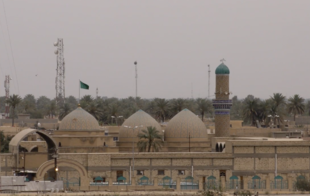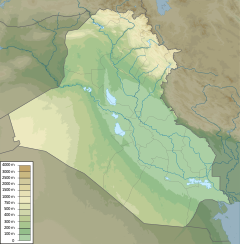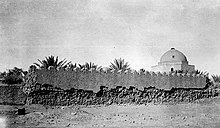| Mosque of Salman al-Farsi | |
|---|---|
| Arabic: مسجد سلمان الفارسي | |
 | |
| Religion | |
| Affiliation | Shi'a |
| District | Al-Mada'in |
| Province | Diyala Province |
| Status | Active |
| Location | |
| Location | Salman Pak, Iraq |
 | |
| Geographic coordinates | 33°05′54″N 44°34′52″E / 33.0982656°N 44.5809823°E / 33.0982656; 44.5809823 |
| Architecture | |
| Type | mosque and mausoleum |
| Style | Modern architecture with elements from Ottoman and Abbasid styles |
| Date established | 1950 (mausoleum existed before that) |
| Specifications | |
| Capacity | at least 800 worshippers |
| Interior area | 500 square metres |
| Dome(s) | 4 |
| Dome height (outer) | 17 metres (main dome) |
| Minaret(s) | 2 |
| Minaret height | 23 metres |
| Shrine(s) | 2 (one shrine for Salman al-Farsi, the other shrine for the companions) |
The Mosque of Salman al-Farsi (Arabic: مسجد سلمان الفارسي) is a historic mosque located in the city of Salman Pak, Al-Mada'in district, Iraq. It contains the purported tomb of Salman al-Farsi, a Sahaba, and this the mosque is named after him.
It is historically a Sunni mosque, however, at some point of time the mosque was removed from the Sunni Endowment and given to the Shi'ite managements.
History

The mosque was established in 1950 over a pre-existing mausoleum dedicated to Salman al-Farsi which was already in existence before the 1920s. In 1931, the bodies of Jabir ibn Abdullah, Hudhayfah ibn al-Yaman, and Ali al-Tahir ibn Muhammad al-Baqir were exhumed due to their graves being water-logged, and the bodies were transferred to new tombs next to the old mausoleum. The report of the bodies being transferred is sometimes contested, however, as Jabir ibn Abdullah is reported to have died in Medina. Later in 1950, the mosque was established over the mausoleum and new tombs, with funding from the Iraqi government.
Modern history

In 2017, a new zarih was placed around the grave of Salman al-Farsi. The ceremony of the placement of the zarih was also attended by Iraj Masjedi, the Iranian ambassador to Iraq, as well as several other Shi'ite clerics.
Usage
The mosque is visited because of the sacred tombs within it. However, the mosque also holds Qur'anic memorization courses as well as classes to study the Shari'ah law. Religious festivals are held in the mosque as well.
2006 attack
Main article: 2006 al-Askari mosque bombingOn February 24, 2006, during the year the Al-Askari Shrine was bombed, two rockets were fired by rebels, which landed in the area of the mosque. Significant damage was caused to the building, but no casualties were reported. Damage was done to the main dome and a minaret.
See also
References
- Silverman, Adam L. (August 24, 2009). "Religion and Politics in Iraq: What Type of Sectarianism Really Exists?". Informed Comment. Retrieved February 5, 2019.
- ^ "مرقد الصحابي الجليل سلمان المحمدي رضوان الله تعالى عليه - اسلاميات". 2017-04-28. Archived from the original on 2017-04-28. Retrieved 2023-12-13.
- Silverman, Adam L. (August 24, 2009). "Religion and Politics in Iraq: What Type of Sectarianism Really Exists?". Informed Comment. Retrieved February 5, 2019.
- IslamQA (2019-08-04). "Where is Jabir ibn Abdullah buried?". IslamQA. Retrieved 2023-12-13.
- "جامع سلمان الفارسي (رضي الله عنه)". almd3aein.ahlamontada.net (in Arabic). Retrieved 2023-12-13.
- ^ "وضع الضريح على مرقد الصحابي سلمان الفارسي في المدائن - قناة العالم الاخبارية". www.alalam.ir (in Arabic). Retrieved 2023-12-13.
- ^ "Rockets hit Shia tomb in Iraq". Al Jazeera. February 27, 2006. Retrieved February 5, 2019.
- "USATODAY.com - Holy Shiite tomb attacked with rockets". usatoday30.usatoday.com. Retrieved 2019-02-03.